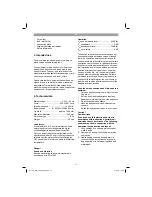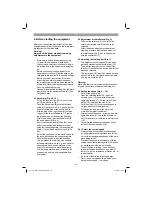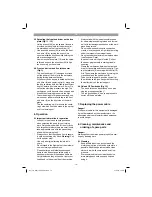
GB
- 18 -
5. Before starting the equipment
Before you connect the equipment to the mains
supply make sure that the data on the rating plate
are identical to the mains data.
Warning!
Always pull the power plug before making
adjustments to the equipment.
•
Make sure the wood lathe stands securely,
i.e. bolt it to a workbench or solid base.
•
All covers and safety devices have to be pro-
perly fitted before the equipment is switched
on.
•
Before you connect the equipment to the
power supply make sure that the data on the
rating plate are identical to the supply voltage.
•
Before you retool the machine (front end
driver ring/face plate) or adjust the speed,
the mains plug must always be pulled first to
prevent the machine being started unintentio-
nally, e.g. by another person.
•
Transport the machine by lifting it by the base
frame (9). Note the equipment’s weight (see
Technical Data).
5.1 Assembly (Fig. 2-5, 13)
•
Screw the thumb screw (12) to the tool sup-
port (3) as shown in Fig. 2.
•
Push the hand wheel (8) onto the tailstock
spindle (7) as shown in Fig. 3. As you do this,
ensure that the side of the hand wheel (8)
with the grub screw is guided over the tape-
red part of the tailstock spindle (7). Tighten
the grub screw with the supplied Allen key
(Fig. 4) and screw the crank handle (20) to
the hand wheel (8) (Fig. 5).
•
Insert the supplied inner profiles (24) in one
half of the machine bed and secure them
using the connecting plate (25) and supplied
screws (19), nuts and washers (see Fig. 2a,
2b).
•
Screw the second half of the machine bed to
the inner profiles and the connecting plate.
•
Secure the machine to a suitable surface
(e.g. a workbench or similar). Use suitable
fastening material to do so, e.g. lock bolts for
securing to a wood-based material or hex
screws for securing to a metal base frame.
The fastening material is not included in the
scope of this delivery and is available from
your dealer.
5.2 Adjustment of the tailstock (Fig. 6)
•
To adjust the tailstock (6), the clip (10) be-
neath the machine bed (9) first has to be
released.
•
After it has been adjusted to the optimum
clamping pressure with the hand wheel (8),
the tailstock spindle (7) has to be secured
with the counternut (5).
5.3 Adjusting the tool support (Fig. 7)
•
The height of the tool support (3) can be ad-
justed by slackening the thumb screw (12).
•
To adjust the length of the tool support (3),
the clip (11) beneath the machine bed (9) first
has to be released.
•
The tool support (3) has to be moved as close
as possible to the workpiece without actually
coming into contact with it.
Warning!
Make sure that the tool support is tightened secu-
rely and cannot turn in towards the workpiece.
5.4 Setting the speed (Fig. 8 – 10)
•
Pull out the power plug.
•
Undo the retaining screw (13), open the
housing cover (16) and slacken the motor
tightening screws (17). Lift the motor V-belt
pulley (18) to slacken the V-belt (19).
•
Shift the V-belt (19) to the required speed le-
vel (pay attention to the alignment).
•
To tension the belt, lower the motor; the
motor’s own weight is sufficient.
•
After adjusting the speed, retighten the motor
tightening screw (17), close the housing co-
ver (16) and secure it with the retaining screw
(13).
•
There is a table showing the speeds on the
inside of the housing cover (16).
5.4.1 Select the correct speed
•
Always start with the lowest possible speed
for new workpieces being turned and increa-
se it with increasing massiveness of the work-
piece being turned.
•
Preselect the speed in accordance with the
cutting speed table, starting with a low speed
for workpieces which are out of round.
•
When it comes to turning, the selection of
the correct speed depends on a number of
factors. (e.g. size, imbalance, material, etc., of
the workpiece)
•
As a rule of thumb, the following applies:
•
Out of round workpieces, large workpieces,
hard pieces of wood – low speed.
Anl_TC_WW_1000_SPK1.indb 18
Anl_TC_WW_1000_SPK1.indb 18
31.03.14 12:50
31.03.14 12:50







































